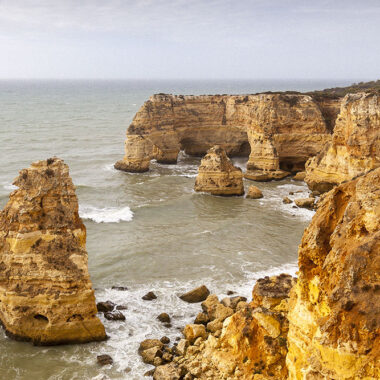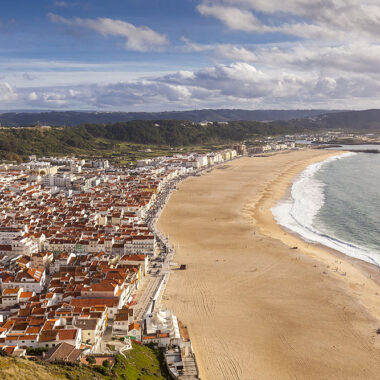Get Directions
From The Algarve we had our sights set on Nazaré on Portugal’s central coast, but none of us had the appetite to drive the almost five hours between the two so we made a stop for the night inÉvora, the capital of Portugal’s south-central Alentejo region. It was a pleasant drive on the motorway, the rolling hills of inland Alentejo filled with not much other than cork trees as far as the eye could see. Amazing how the cork is harvested, pulled off in large sheets from the lower trunks of the trees and then regenerated over a period of 10-or-so years before it can be harvested again. On our way north we stopped off at the colossal operation of Herdade do Esporão winery in the Reguengos de Monsaraz municipality to the southeast of Évora. A friend of ours from Adelaide – Riley Harrison – worked at Herdade do Esporão for the 2013 vintage and suggested we stop by if in the area. It was a massive property, so large that after we entered the gate we had to drive another two kilometers/1.2 miles to get to the actual winery. They even offered bikes to visitors so they could spent the day riding through the vineyards and exploring the property in its entirety. The tasting room was very nicely done and Lisa enjoyed sampled the winery’s wares, especially some of the interesting concoctions the winemaker had put together using amphoras as fermentation vessels.
Évora’s a popular stop for tourists due to its well-preserved old town – which is still partially enclosed by medieval walls – and also due to the fact that the old town is a UNESCO World Heritage Site. Given it was halloween we rolled the dice and chanced some subsequent nightmares for the kids with a tour through Évora’s Chapel of Bones: a hall next to the Igreja de São Francisco with walls decorated with literally thousands of human remains, arranged by the Franciscans more than 500 years ago. It was very eerie, especially the remains of a full human – cartilage and all – preserved in a glass casket that was on display. Max was enthralled by the bones and was absolutely full of questions. Lilia, on the other hand, was decidedly reserved about the whole experience, very quiet throughout. The museum above the chapel was also excellent, filled with centuries-old relics from the Franciscans’ occupation of the city. All the items on display dated from at least the 18th century, with a handful – like the crown and manuscript pictured below – more than 500 years old.
Évora’s old town was interesting to explore on foot, with its quaint stone-lined streets and handful of archaeological sites. We had to dodge the rain a little while we explored but fortunately nothing too bad. Some of the galleries and pottery stores had beautiful items for sale, particularly some of the hand-painted serving dishes. Lisa and I were wishing we had space in our bags for some souvenirs, but neither of us thought they’d survive another couple of months on the road. Lilia did snag herself a souvenir, though: a tote made from local cork to replace the one her Great Auntie Anita gave her that broke a couple of weeks back. The size of Catedral de Évora was astonishing, such a behemoth structure, and it was also interesting to stroll around the remains of Templo Romano Évora. The temple was constructed around the first century in honor of the first Roman emperor Augustus, who was venerated as a god during and after his rule. To think those columns had stood there for more than 2000 years.
A little more history on our way north out ofÉvora towards Nazaré with a stop at Cromeleque dos Almendres. The stones of the cromlech were arranged during the Neolithic period more than 8000 years ago and represent various constellations visible from the region of Portugal where they stand. I don’t think the age of the stone arrays really sunk into the kids, but I thought it was a very interesting foray into the countryside (credit to Lisa for discovering this one!).





































































Some very familiar and memorable sites from past touring an ancient part of the world.